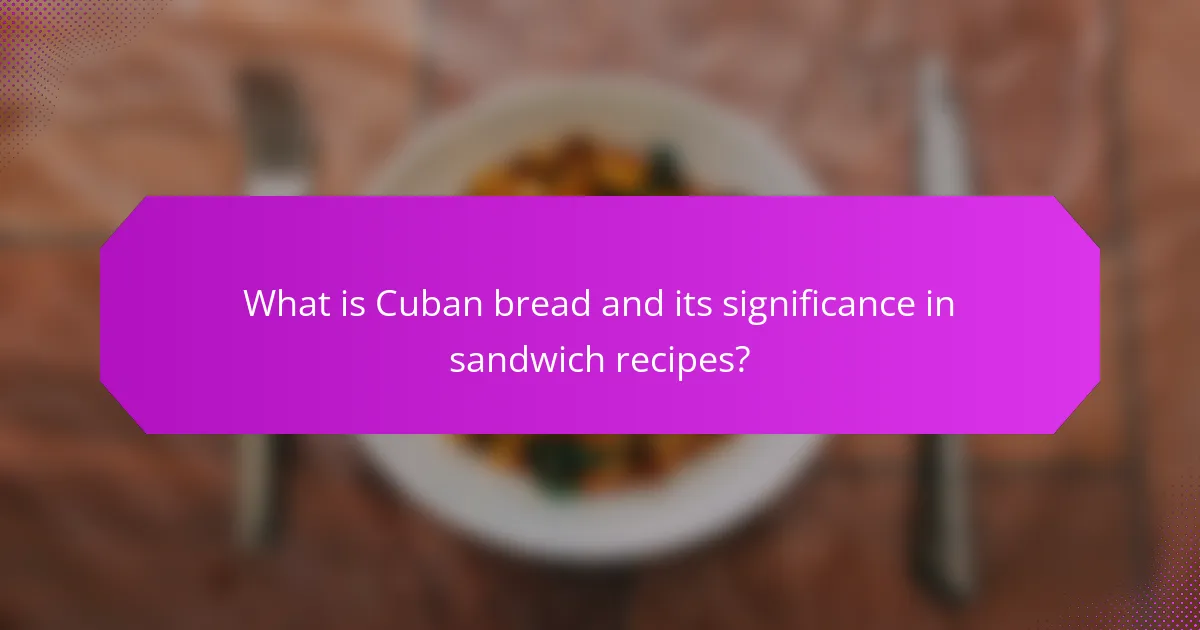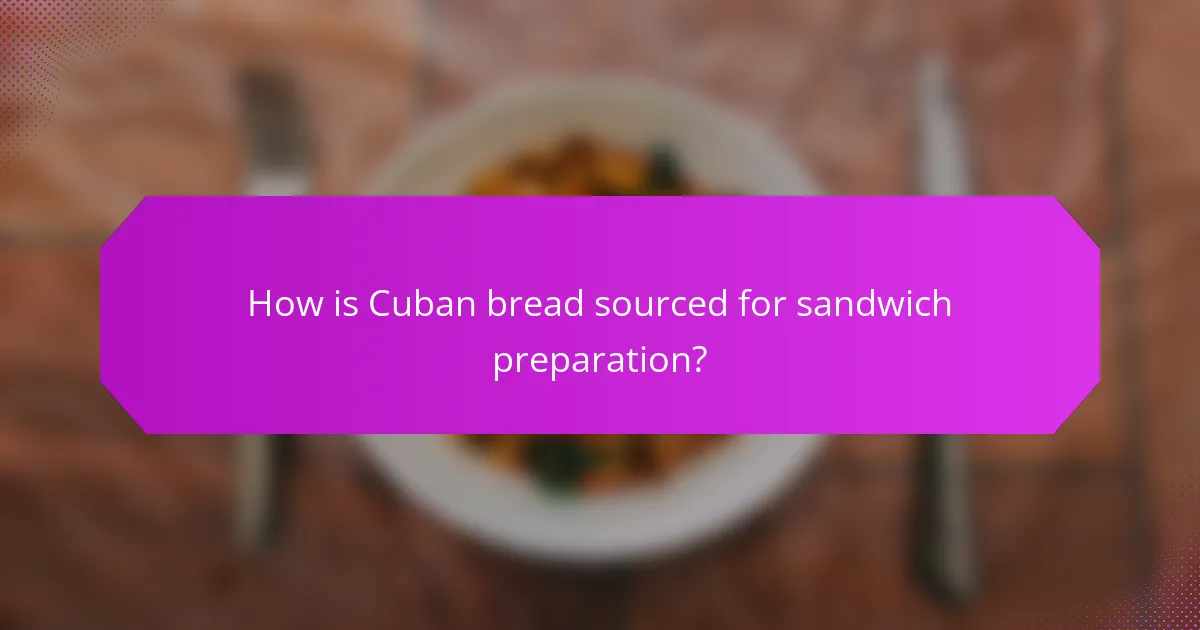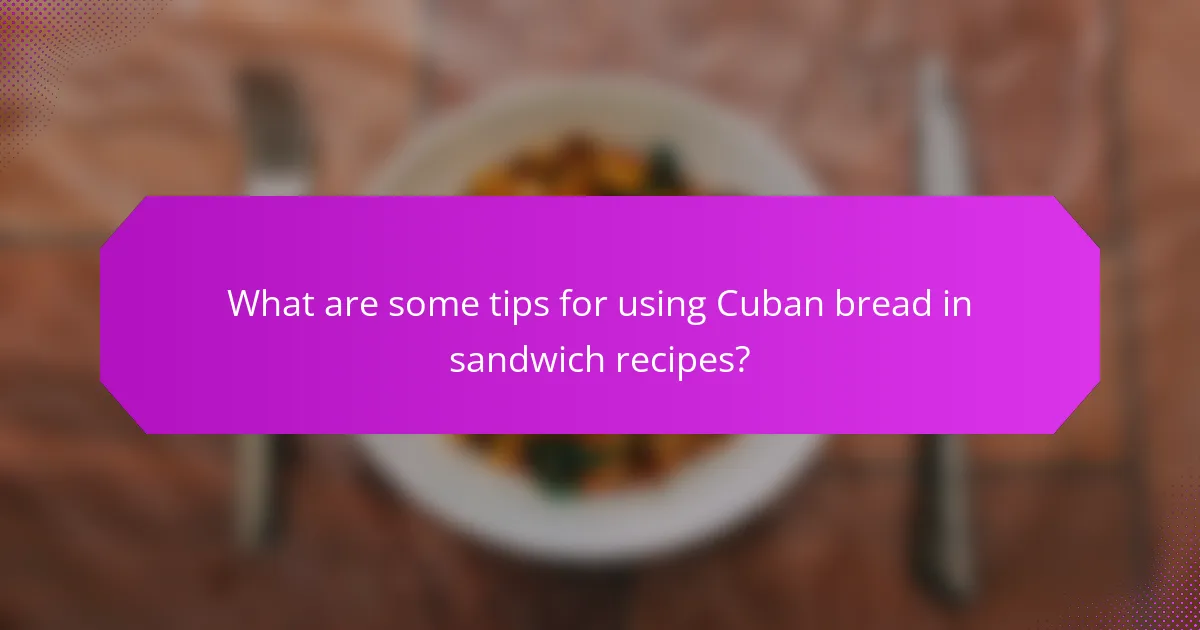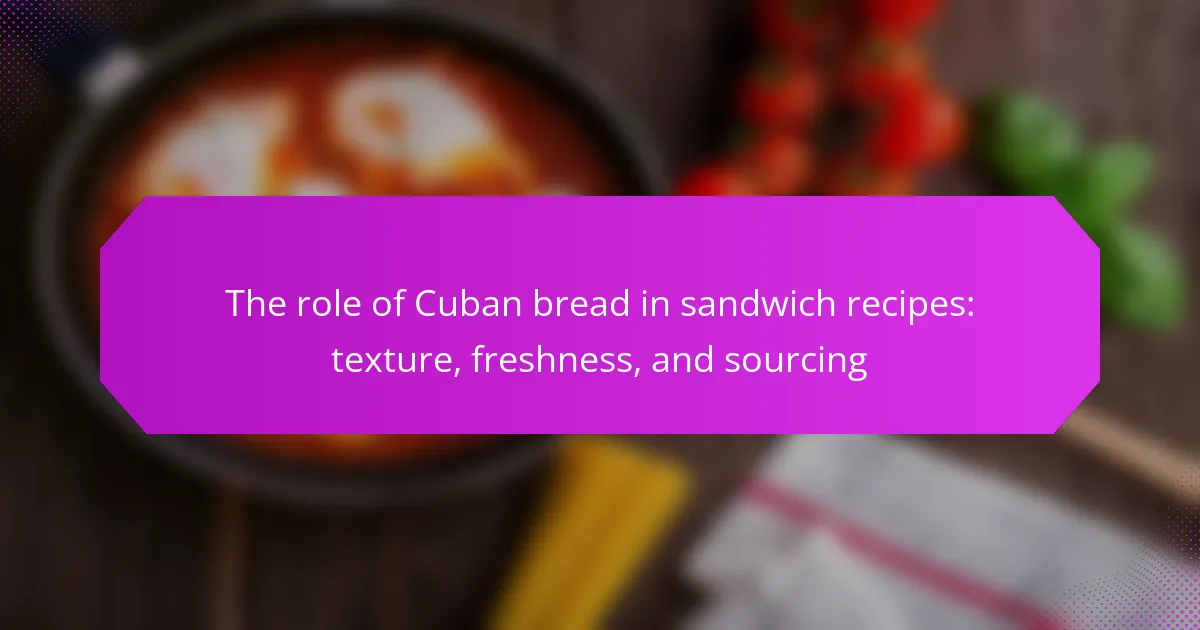Cuban bread is a type of white bread known for its soft texture and crispy crust, traditionally made with flour, water, yeast, and lard. It plays a crucial role in sandwich recipes, particularly in the Cuban sandwich, due to its ability to withstand moist ingredients while enhancing flavor and texture when pressed or toasted. This article explores the significance of Cuban bread in sandwich preparation, emphasizing the importance of sourcing from local bakeries that adhere to traditional recipes for optimal freshness and quality. Additionally, it highlights how to effectively use Cuban bread to create authentic, flavorful sandwiches by layering ingredients and ensuring proper storage and reheating techniques.

What is Cuban bread and its significance in sandwich recipes?
Cuban bread is a type of white bread that is characterized by its soft texture and crispy crust. It is traditionally made with flour, water, yeast, and lard, which contributes to its unique flavor and texture. Cuban bread is significant in sandwich recipes, particularly in the preparation of the Cuban sandwich. This bread holds up well against moist ingredients, making it ideal for sandwiches that contain meats, cheeses, and condiments. The bread’s ability to be pressed and toasted enhances the overall flavor and texture of the sandwich. Its origins trace back to Cuban immigrants in Florida, solidifying its cultural importance. Cuban bread is often sought after for authentic Cuban sandwich experiences.
How is Cuban bread traditionally made?
Cuban bread is traditionally made using a specific process that includes unique ingredients and techniques. The primary ingredients are flour, water, yeast, and salt. A small amount of sugar and fat, typically lard or vegetable shortening, is also added to enhance flavor and texture.
The dough is mixed and kneaded until smooth and elastic. After kneading, it undergoes a fermentation process, allowing it to rise. This rising time typically lasts about an hour.
After the first rise, the dough is shaped into long loaves. The loaves are then placed on a baking sheet or in a baking pan, where they rise again for a shorter period.
To achieve the characteristic crust, Cuban bread is often baked in a hot oven with steam. This steam helps create a crispy exterior while maintaining a soft interior. The bread is usually baked until it reaches a golden brown color.
Cuban bread is known for its light, airy texture and slightly sweet flavor, making it ideal for sandwiches. Its traditional preparation methods have been passed down through generations, ensuring authenticity in taste and texture.
What ingredients are essential for authentic Cuban bread?
Authentic Cuban bread requires flour, water, yeast, salt, and sugar. The flour is typically all-purpose or a combination of all-purpose and bread flour. Water hydrates the dough and activates the yeast. Yeast is essential for fermentation, allowing the bread to rise. Salt enhances flavor and controls yeast activity. Sugar contributes to browning and adds a slight sweetness. These ingredients combine to create the distinctive texture and flavor of Cuban bread, which is crucial for making traditional Cuban sandwiches.
How does the baking process influence Cuban bread’s characteristics?
The baking process significantly influences Cuban bread’s characteristics. Baking creates a crispy crust while maintaining a soft, airy interior. The high-temperature baking allows for proper oven spring, leading to a light texture. Additionally, the steam introduced during baking contributes to the bread’s unique chewiness. The Maillard reaction during baking enhances flavor, giving Cuban bread its distinctive taste. The duration and temperature of baking directly affect the color and aroma of the bread. Properly baked Cuban bread achieves a golden-brown crust and a tender crumb, making it ideal for sandwiches.
Why is texture important in sandwich recipes using Cuban bread?
Texture is important in sandwich recipes using Cuban bread because it contributes to the overall eating experience. Cuban bread features a crispy crust and a soft interior. This contrast enhances the flavors and ingredients within the sandwich. A well-textured bread can hold fillings without becoming soggy. It also provides a satisfying crunch when bitten into. The texture influences how the sandwich feels in the mouth, impacting enjoyment. Furthermore, the right texture can elevate a simple sandwich to a gourmet experience. Therefore, the texture of Cuban bread is crucial for creating a balanced and enjoyable sandwich.
What texture qualities make Cuban bread suitable for sandwiches?
Cuban bread has a unique texture that makes it suitable for sandwiches. It features a crisp crust that provides a satisfying crunch. The interior is soft and airy, allowing for easy biting and chewing. This combination of textures prevents the bread from becoming soggy when filled with moist ingredients. Cuban bread’s elasticity helps it hold its shape under pressure. Its lightness complements various fillings without overwhelming them. Additionally, the bread’s slightly chewy quality enhances the overall eating experience. These texture qualities make Cuban bread an ideal choice for crafting delicious sandwiches.
How does the texture of Cuban bread enhance the overall sandwich experience?
The texture of Cuban bread significantly enhances the overall sandwich experience. Cuban bread features a crispy crust and a soft, airy interior. This contrast creates a satisfying bite that complements various fillings. The crust provides a protective layer that helps retain moisture inside the sandwich. This moisture retention prevents ingredients from becoming soggy. Additionally, the lightness of the bread allows for a balance between flavors. The unique texture also encourages the bread to absorb sauces and juices without falling apart. Overall, the texture of Cuban bread contributes to a pleasurable and cohesive eating experience.
What role does freshness play in the use of Cuban bread for sandwiches?
Freshness is crucial in the use of Cuban bread for sandwiches. Fresh Cuban bread has a crispy crust and a soft interior. This texture enhances the overall eating experience. Stale bread can result in a chewy or hard sandwich. Freshness also affects flavor, making the bread taste more vibrant. A study by the American Association of Cereal Chemists found that fresh bread retains more moisture and flavor compounds. Therefore, using fresh Cuban bread significantly improves the quality of sandwiches.
How does the freshness of Cuban bread affect flavor and texture?
The freshness of Cuban bread significantly enhances both its flavor and texture. Fresh Cuban bread has a soft, airy interior and a crispy crust. This combination provides a satisfying mouthfeel. The flavor is more pronounced when the bread is fresh, offering a slightly sweet and yeasty taste. Stale Cuban bread becomes dry and hard, diminishing its appeal in sandwiches. In contrast, fresh bread retains moisture, allowing for better absorption of sandwich fillings. Studies indicate that bread loses quality rapidly after baking, with noticeable changes in texture and taste within a day. Therefore, consuming Cuban bread shortly after baking maximizes its flavor and texture benefits.
What are the best practices for ensuring Cuban bread remains fresh?
To ensure Cuban bread remains fresh, store it in a paper bag at room temperature. This method allows the bread to breathe while preventing it from becoming soggy. Avoid plastic bags, as they trap moisture and lead to mold growth. For longer storage, freeze the bread. Wrap it tightly in plastic wrap, then place it in a freezer bag. When ready to use, thaw it at room temperature or warm it in the oven. According to experts, these practices help maintain the bread’s texture and flavor for a longer period.

How is Cuban bread sourced for sandwich preparation?
Cuban bread is sourced primarily from local bakeries that specialize in traditional Cuban recipes. These bakeries often use specific ingredients like flour, yeast, and lard to create the unique texture and flavor. Cuban bread is typically baked in a hot oven, which results in a crispy crust and soft interior. Many bakeries also follow age-old techniques to ensure authenticity. Sourcing from these establishments guarantees freshness, as the bread is often made daily. Additionally, some grocery stores may carry Cuban bread made by local bakers, providing wider access. The quality of the bread is crucial for sandwich preparation, as it enhances the overall taste and experience.
Where can you find authentic Cuban bread?
Authentic Cuban bread can be found at Cuban bakeries and specialty grocery stores. Cities with significant Cuban populations, such as Miami, often have bakeries that produce this bread daily. Some well-known establishments include La Segunda Central Bakery in Tampa and Versailles Restaurant in Miami. These locations are renowned for their traditional methods and fresh ingredients. Additionally, some supermarkets may carry Cuban bread in their international food sections.
What are the key characteristics to look for when sourcing Cuban bread?
Key characteristics to look for when sourcing Cuban bread include a crispy crust and a soft, airy interior. The crust should be golden and slightly crunchy, providing a satisfying texture. The interior must be light and fluffy, allowing it to hold fillings without becoming soggy. Authentic Cuban bread often contains a touch of lard, which enhances its flavor and texture. Additionally, sourcing from local bakeries that specialize in Cuban bread ensures freshness. The bread should be consumed within a day or two of baking for optimal taste. Recognizing these traits is essential for selecting high-quality Cuban bread for sandwiches.
How does sourcing impact the quality of Cuban bread in recipes?
Sourcing directly impacts the quality of Cuban bread in recipes. The origin of ingredients like flour, yeast, and sugar affects the bread’s texture and flavor. High-quality flour, for example, contributes to a better crumb structure. Fresh yeast enhances the fermentation process, leading to a lighter bread. Additionally, sourcing local ingredients can improve freshness, which is crucial for optimal taste. Authentic Cuban bread often uses specific types of flour, such as all-purpose or bread flour, which can vary by region. The use of traditional methods and local sourcing can also preserve the cultural integrity of the bread. Overall, sourcing influences the final product’s authenticity and quality in Cuban bread recipes.
What are the differences between commercially produced and artisanal Cuban bread?
Commercially produced Cuban bread is typically mass-manufactured using industrial processes. This bread often contains preservatives to extend shelf life. In contrast, artisanal Cuban bread is made in smaller batches with traditional methods. It usually features fewer ingredients, focusing on natural flavors. The texture of artisanal bread is often denser and chewier, while commercial bread tends to be lighter and airier. Artisanal Cuban bread also often uses a longer fermentation process, enhancing its flavor profile. Additionally, artisanal varieties may vary in shape and crust thickness, reflecting the baker’s style. Commercially produced bread often has a uniform appearance due to standardization in production.
How do production methods affect the attributes of Cuban bread?
Production methods significantly influence the attributes of Cuban bread. Traditional methods involve using a starter dough, which enhances flavor and texture. The fermentation process develops a unique taste profile. Baking in a steam-injected oven creates a crispy crust while keeping the inside soft. The use of specific ingredients, like lard, adds richness to the bread. Variations in kneading and proofing times also affect the bread’s density and chewiness. Historically, Cuban bread is characterized by its long, thin shape, which results from these methods. Overall, the production techniques directly impact the sensory qualities that define Cuban bread.
Why might one prefer artisanal Cuban bread over mass-produced options?
One might prefer artisanal Cuban bread over mass-produced options for its superior flavor and quality. Artisanal Cuban bread is often made with traditional methods and high-quality ingredients. This results in a unique taste that mass-produced bread lacks. The texture of artisanal bread is typically crustier and more satisfying. Freshness is another key factor; artisanal bread is usually baked in smaller batches. This means it is often fresher than mass-produced varieties. Additionally, artisanal bakers may use natural fermentation processes. These processes enhance the bread’s flavor and nutritional profile. Overall, the craftsmanship involved in making artisanal Cuban bread contributes to its appeal.

What are some tips for using Cuban bread in sandwich recipes?
Use Cuban bread to create flavorful sandwiches by leveraging its unique texture and taste. Toast or grill the bread for added crunch. This enhances the overall sandwich experience. Layer ingredients generously to complement the bread’s airy structure. Use traditional fillings like roasted pork, ham, and pickles for authenticity. Cuban bread’s slight sweetness pairs well with savory ingredients. Ensure the bread is fresh for the best flavor and texture. Store leftover bread in a paper bag to maintain its crust. Reheat in an oven to revive its original texture before serving.
How can you effectively pair Cuban bread with various fillings?
Cuban bread pairs well with a variety of fillings due to its soft texture and crispy crust. Common fillings include roasted pork, ham, cheese, and pickles. The bread’s lightness complements rich flavors, enhancing the overall taste. For a classic Cuban sandwich, layer roasted pork, ham, Swiss cheese, and dill pickles. Press the sandwich to meld the flavors and achieve a crispy exterior. Additionally, Cuban bread works well with vegetarian options like grilled vegetables and cheese. The bread’s ability to absorb moisture makes it ideal for juicy fillings without becoming soggy.
What types of fillings complement the texture of Cuban bread?
Savory fillings like roasted pork, ham, and Swiss cheese complement the texture of Cuban bread. These fillings provide a rich contrast to the soft, airy interior of the bread. The crispy crust of Cuban bread also enhances the overall experience. Traditional Cuban sandwiches often feature these ingredients. Additionally, pickles and mustard add a tangy flavor that balances the richness of the meats. The combination of textures and flavors creates a satisfying bite. This pairing is rooted in Cuban culinary traditions. Therefore, the choice of fillings is essential for maximizing the enjoyment of Cuban bread.
How can the freshness of Cuban bread enhance specific sandwich fillings?
Freshness of Cuban bread enhances sandwich fillings by providing optimal texture and flavor. Fresh Cuban bread has a crispy crust and a soft, airy interior. This contrast complements various fillings, such as roasted pork or ham. The bread’s moisture retention prevents fillings from becoming soggy. Freshness also ensures the bread retains a pleasant aroma, enhancing the overall eating experience. Additionally, the slight sweetness of fresh Cuban bread balances savory ingredients. Studies show that fresh bread improves consumer satisfaction in sandwiches. Thus, using fresh Cuban bread elevates the quality of the entire sandwich.
What are common mistakes to avoid when using Cuban bread in sandwiches?
Common mistakes to avoid when using Cuban bread in sandwiches include using stale bread, which negatively impacts texture. Cuban bread should be fresh to maintain its signature crust and soft interior. Another mistake is not toasting the bread, as toasting enhances flavor and prevents sogginess. Overfilling the sandwich can also lead to a messy experience, making it difficult to eat. Additionally, using the wrong ingredients can overpower the bread’s unique taste. Finally, neglecting to properly slice the bread can affect the sandwich’s overall presentation and ease of consumption.
How can improper handling of Cuban bread affect the final sandwich?
Improper handling of Cuban bread can lead to a subpar final sandwich. If Cuban bread is stored incorrectly, it can become stale or dry. Stale bread fails to provide the desired texture and flavor in a sandwich. Additionally, mishandling during preparation can result in tearing or crumbling. This affects the structural integrity of the sandwich. The bread should be handled gently to maintain its soft crust and airy interior. A well-handled Cuban bread enhances the overall taste and experience of the sandwich. Proper storage and careful preparation are essential for optimal results.
What are the best techniques for toasting or grilling Cuban bread for sandwiches?
The best techniques for toasting or grilling Cuban bread for sandwiches include using a skillet, grill, or oven. For skillet toasting, preheat the skillet over medium heat. Lightly butter the outside of the bread for enhanced flavor and crispness. Place the bread in the skillet and toast until golden brown, about 3-4 minutes per side.
For grilling, preheat the grill to medium-high. Butter the bread as well and place it directly on the grill. Grill each side for about 2-3 minutes until grill marks appear and the bread is crispy.
Using an oven is another effective method. Preheat the oven to 375°F (190°C). Place the bread on a baking sheet and bake for 8-10 minutes, flipping halfway through. This method ensures even toasting while maintaining a soft interior.
These techniques enhance the texture and flavor of Cuban bread, making it ideal for sandwiches.
Cuban bread is a type of white bread known for its soft texture and crispy crust, essential in creating authentic Cuban sandwiches. This article explores the significance of Cuban bread in sandwich recipes, emphasizing its texture, freshness, and sourcing practices. Key topics include traditional preparation methods, the impact of freshness on flavor, and best practices for using Cuban bread in sandwiches. Additionally, the article addresses the differences between artisanal and commercially produced Cuban bread, highlighting how sourcing influences quality and authenticity.
